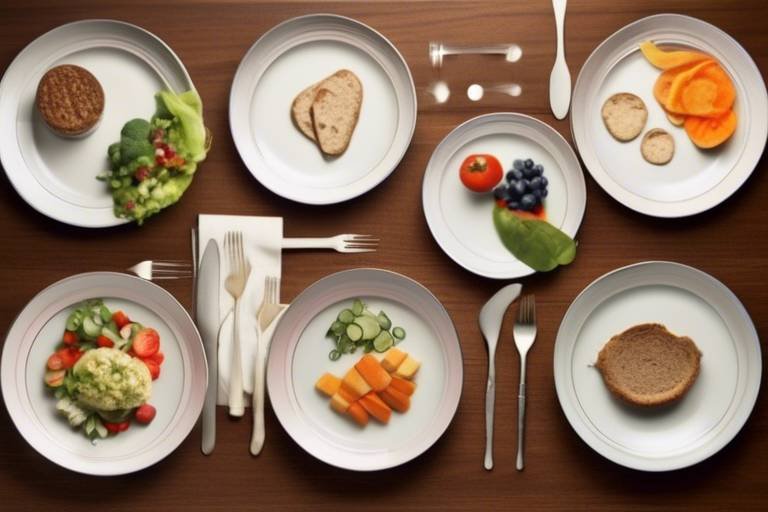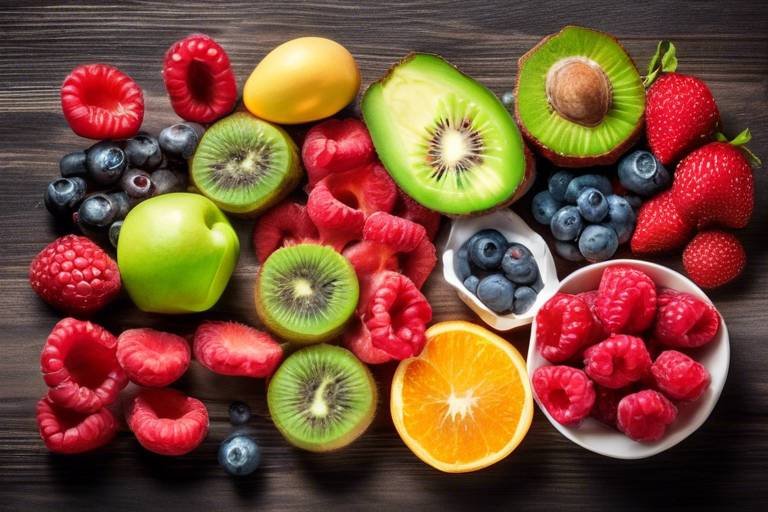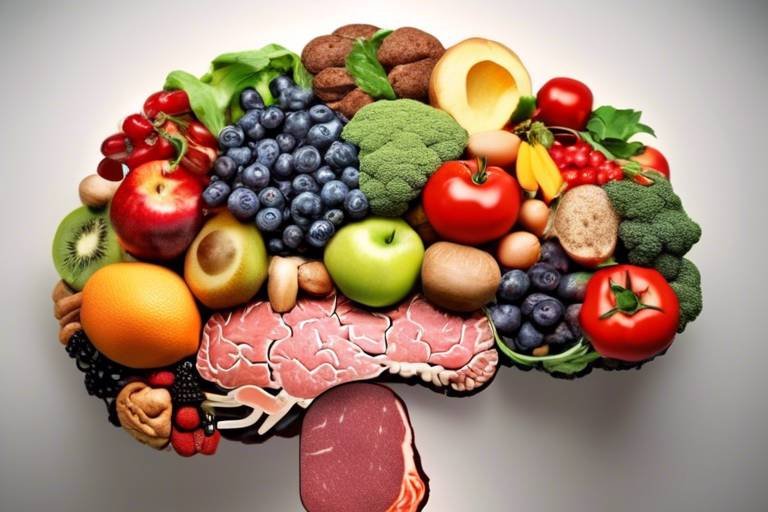Nutritious Family Meals for Kids with Food Allergies
In today's world, where food allergies are becoming increasingly common among children, it is essential for families to adapt their meal planning to ensure that every meal is both nutritious and delicious. Food allergies can be overwhelming, not just for the child who suffers from them but for the entire family. The challenge lies in creating meals that everyone can enjoy without compromising on flavor or nutrition. Imagine sitting around the dinner table, laughter filling the air, as everyone digs into a meal that is safe for all, yet bursting with flavors. This article will guide you through the journey of crafting nutritious family meals that cater to kids with food allergies, ensuring that everyone leaves the table satisfied.
Understanding the specific allergens your child faces is the first step in this culinary adventure. Common allergens include gluten, dairy, nuts, soy, and eggs, each presenting its own set of challenges when it comes to meal preparation. However, with a little creativity and resourcefulness, you can whip up meals that not only meet dietary restrictions but also excite the taste buds. Think of it as a puzzle, where each piece represents a different ingredient or flavor, and your goal is to fit them together to create a wholesome picture of family dining.
As we dive deeper, we'll explore meal planning strategies that will help you navigate this landscape. From ingredient substitutions to organizing meals that maximize both nutrition and safety, you'll find that the kitchen can be a place of innovation. Remember, the key to success is not just about avoiding allergens but also about ensuring that meals are balanced and fulfilling. In the upcoming sections, we will delve into safe ingredient substitutions, balanced meal creation, and fun recipes that the whole family will love.
So, whether you're a seasoned chef or just starting on your cooking journey, this guide is designed to empower you with the knowledge and tools needed to create wholesome meals that cater to your child's needs. Let’s embark on this delicious journey together, turning potential obstacles into opportunities for creativity and connection around the dinner table.

Understanding Food Allergies
Food allergies are more common than you might think, especially among children. They can turn mealtime into a challenging experience for families, but understanding these allergies is the first step towards creating safe and nutritious meals. What exactly are food allergies? In simple terms, a food allergy occurs when the body's immune system mistakenly identifies a harmless food as a threat, triggering an allergic reaction. This can lead to a range of symptoms, from mild discomfort to severe, life-threatening reactions.
Some of the most common food allergies in children include:
- Peanuts
- Tree nuts
- Dairy
- Eggs
- Wheat
- Soy
- Fish
- Shellfish
Each of these allergens can provoke different symptoms, ranging from hives and stomachaches to more severe reactions like anaphylaxis. It's crucial for parents to recognize these symptoms early on. Common signs of food allergies include:
- Skin reactions such as hives or eczema
- Respiratory issues like wheezing or nasal congestion
- Digestive problems, including nausea, vomiting, or diarrhea
- Anaphylaxis, a severe reaction that requires immediate medical attention
Understanding food allergies is not just about recognizing the allergens themselves; it’s also about knowing how to avoid them. This means reading labels carefully, asking questions when dining out, and educating your children about their allergies. Involving children in this process can empower them and help them make safe choices, especially as they grow older and start to navigate food options independently.
Moreover, the importance of identifying allergens cannot be overstated. It allows families to create meal plans that are not only safe but also nutritious. By knowing what to avoid, parents can focus on incorporating a variety of healthy foods that cater to their children's dietary needs. This way, children can enjoy delicious meals without the constant worry of allergic reactions.
In summary, understanding food allergies is essential for creating safe and enjoyable mealtimes. By recognizing common allergens, being aware of symptoms, and taking proactive steps to avoid exposure, families can ensure that their children receive the nutrition they need without compromising their health. As we delve deeper into meal planning strategies and safe ingredient substitutions, you'll discover how to turn these challenges into opportunities for creativity in the kitchen!

Meal Planning Strategies
When it comes to feeding kids with food allergies, meal planning can feel like navigating a minefield. But fear not! With a little creativity and some strategic thinking, you can whip up delicious meals that cater to your child's dietary needs without sacrificing flavor or nutrition. The secret lies in understanding your child's specific allergies and being open to exploring new ingredients. Have you ever thought about how meal planning can be a fun family activity? It can transform your kitchen into a culinary playground where everyone contributes to creating safe and tasty dishes!
One effective strategy is to focus on ingredient substitutions. For instance, if your child is allergic to dairy, consider using almond milk or coconut yogurt instead of traditional dairy products. Not only do these alternatives taste great, but they also pack a nutritional punch. Another tip is to organize your meals by theme. For example, you could dedicate one night to "Taco Tuesday" where you can use corn tortillas (gluten-free) and fill them with a variety of allergy-friendly toppings. This not only keeps things exciting but also makes it easier to plan your grocery list.
It's also essential to keep a well-stocked pantry with safe ingredients. This means having a selection of gluten-free grains, dairy-free options, and protein sources that are free from allergens. You might want to create a meal planning chart that outlines your weekly meals. This chart can help you visualize what you need to buy and prepare. Here’s a simple example:
| Day | Meal | Allergen-Free Ingredients |
|---|---|---|
| Monday | Quinoa Salad | Quinoa, mixed veggies, olive oil, lemon juice |
| Tuesday | Taco Night | Corn tortillas, ground turkey, avocado, salsa |
| Wednesday | Stir-Fry | Brown rice, chicken, broccoli, tamari sauce |
| Thursday | Veggie Pasta | Gluten-free pasta, marinara sauce, spinach |
| Friday | Homemade Pizza | Gluten-free crust, dairy-free cheese, veggies |
Don't forget to involve your kids in the planning process! Let them pick a meal or two that they want to try, which can make them more excited about what’s on their plate. This way, mealtime becomes an adventure rather than a chore. Plus, it’s a great way for them to learn about their dietary restrictions in a fun and engaging manner. Remember, meal planning is not just about avoiding allergens; it's about creating a joyful and inclusive dining experience for the whole family.

Safe Ingredient Substitutions
When it comes to preparing meals for children with food allergies, finding is crucial. It's like being a chef in a culinary adventure where you need to navigate through a maze of dietary restrictions while still serving up delicious and nutritious dishes. The good news is that there are plenty of alternatives available that can easily replace common allergens without sacrificing flavor or nutrition.
One of the most common allergens is wheat, which can be a challenge for families trying to create gluten-free meals. Instead of traditional wheat flour, consider using alternatives like almond flour, coconut flour, or rice flour. These ingredients not only provide a gluten-free option but also add unique flavors and textures to your dishes. For instance, almond flour can make your pancakes fluffier, while coconut flour can lend a subtle sweetness to baked goods. It's all about experimenting and finding what works best for your family's taste buds!
Another major allergen is dairy. For kids who are lactose intolerant or allergic to dairy, there are numerous alternatives that can be used in recipes. Coconut milk, almond milk, and oat milk are fantastic substitutes for cow's milk. They can be used in smoothies, cereals, or even in baking. Additionally, nut-based cheeses and coconut yogurt can satisfy cravings for creamy textures without the dairy. Just like finding the right key to unlock a door, these substitutions can open up a world of culinary possibilities.
For those avoiding eggs, there are several effective replacements that can keep your recipes intact. Flaxseed meal mixed with water, or applesauce, can serve as excellent egg substitutes in baking. For example, using one tablespoon of flaxseed meal with three tablespoons of water can replace one egg in your favorite cookie recipe. It’s a simple trick that can make a big difference!
Finally, when it comes to sweetening your dishes, traditional sugar can sometimes be a concern. Instead, consider using maple syrup, honey, or agave nectar as natural sweeteners. These alternatives not only add sweetness but also bring unique flavors to your meals. It’s like adding a touch of magic to your cooking, transforming a simple dish into something extraordinary.
In summary, by understanding and utilizing safe ingredient substitutions, you can create meals that are both nutritious and delicious for your children with food allergies. The key is to be creative and open-minded, allowing your culinary skills to shine while ensuring that everyone at the table enjoys their meal without worry.
| Common Allergen | Safe Substitute |
|---|---|
| Wheat | Almond flour, Coconut flour, Rice flour |
| Dairy | Coconut milk, Almond milk, Oat milk |
| Eggs | Flaxseed meal, Applesauce |
| Sugar | Maple syrup, Honey, Agave nectar |
Q: What should I do if my child has multiple food allergies?
A: It can be challenging, but focusing on whole foods and using safe substitutions can help create a diverse diet. Always consult with a healthcare provider or dietitian for personalized advice.
Q: How can I ensure my child is getting enough nutrients with food allergies?
A: Incorporate a variety of fruits, vegetables, proteins, and healthy fats into their meals. Using fortified alternatives can also help meet their nutritional needs.
Q: Are there any resources for finding allergy-friendly recipes?
A: Yes! There are many websites and cookbooks dedicated to allergy-friendly cooking. Additionally, joining online communities can provide support and recipe ideas from other parents.

Gluten-Free Alternatives
When it comes to feeding children with food allergies, particularly gluten intolerance or celiac disease, finding can feel like navigating a maze. But fear not! There are numerous delicious options that can seamlessly replace traditional gluten-containing ingredients without sacrificing flavor or nutrition. Imagine swapping out your regular pasta for a delightful quinoa or brown rice pasta that not only satisfies but also packs a nutritional punch. It's all about making smart choices that cater to your child's needs while keeping mealtime fun and exciting.
One of the most popular gluten-free grains is quinoa. This tiny seed is not only gluten-free but also a complete protein, making it an excellent choice for growing kids. You can use quinoa in salads, as a base for stir-fries, or even as a breakfast porridge. Another fantastic option is brown rice, which can be used in various dishes, from sushi to fried rice, offering a hearty and filling meal. If you're looking for something a little different, consider amaranth or millet, both of which are nutritious and versatile grains that can be used in a variety of recipes.
For those who love baked goods, gluten-free flours such as almond flour, coconut flour, and chickpea flour can be game-changers. These flours not only provide a gluten-free base for cookies, cakes, and pancakes but also add unique flavors and nutrients. For instance, almond flour is rich in healthy fats and protein, making it a fantastic choice for hearty muffins or pancakes that your kids will adore. You can even mix different gluten-free flours to achieve the perfect texture in your baked goods.
Moreover, don't overlook the power of gluten-free oats. These can be a great breakfast option when prepared as oatmeal or used in energy bars. Just ensure they are labeled gluten-free, as cross-contamination can occur during processing. And speaking of snacks, gluten-free pretzels or popcorn can be excellent choices for munching while watching a movie at home, keeping those cravings at bay without the worry of allergens.
Incorporating these gluten-free alternatives into your family's meals not only ensures safety for your child but also opens the door to a world of flavors and textures. It’s all about creativity and exploration in the kitchen! Remember, the goal is to make meals enjoyable and satisfying for your little ones while adhering to their dietary needs.
- What are some common gluten-free grains? Quinoa, brown rice, amaranth, and millet are excellent gluten-free grains.
- Can I use regular flour for gluten-free recipes? No, regular flour contains gluten. Use gluten-free alternatives like almond or coconut flour instead.
- Are gluten-free products healthier? While gluten-free products can be healthier for those with gluten intolerance, it's important to check for added sugars and preservatives.
- How can I ensure my meals are truly gluten-free? Always read labels and look for certified gluten-free products to avoid cross-contamination.

Dairy-Free Options
When it comes to feeding kids with food allergies, finding can feel like navigating a maze. But fear not! There are plenty of delicious alternatives that can help you whip up meals without compromising on taste or nutrition. If you're wondering how to keep your family happy and healthy while avoiding dairy, you're in the right place!
First off, let's talk about the importance of dairy substitutes. Many families find themselves relying on dairy for calcium and other essential nutrients, but there are numerous plant-based options that can fulfill these needs. For instance, almond milk, coconut yogurt, and cashew cheese can be fantastic replacements. They not only offer a similar texture but also bring unique flavors to your dishes. Imagine a creamy pasta made with cashew cream instead of heavy cream—trust me, your taste buds won't even notice the difference!
When planning meals, consider incorporating these dairy-free alternatives:
- Milk Alternatives: Almond, soy, oat, and coconut milk are excellent options that can be used in everything from smoothies to baking.
- Yogurt Substitutes: Look for coconut or almond-based yogurts that are fortified with calcium and probiotics, making them a healthy choice for breakfast or snacks.
- Cheese Alternatives: Nutritional yeast can add a cheesy flavor to dishes, while brands like Daiya offer a variety of dairy-free cheese products that melt beautifully.
Additionally, if you're making desserts, there are plenty of dairy-free options that can satisfy any sweet tooth. For instance, coconut cream can be whipped to create a luscious topping for cakes and pies. And did you know that avocado can be blended into smoothies or used in chocolate mousse for a creamy texture without any dairy?
To make your life easier, here’s a quick comparison table of common dairy products and their dairy-free alternatives:
| Dairy Product | Dairy-Free Alternative |
|---|---|
| Milk | Almond Milk, Soy Milk, Oat Milk |
| Yogurt | Coconut Yogurt, Almond Yogurt |
| Butter | Coconut Oil, Vegan Butter |
| Cheese | Cashew Cheese, Nutritional Yeast |
Incorporating these dairy-free options into your family's meals can be both a fun and rewarding experience. Not only will you ensure that your little ones are safe from allergens, but you'll also introduce them to a world of flavors and textures that they might not have tried before. So, roll up your sleeves and get creative in the kitchen! Your kids will thank you for it, and you might just discover some new family favorites along the way.

Creating Balanced Meals
When it comes to for kids with food allergies, the goal is to ensure that every plate is not only safe but also packed with the essential nutrients that growing bodies need. Think of a balanced meal as a colorful palette; each color represents different food groups, and together they create a masterpiece of nutrition. The key components to focus on are proteins, healthy fats, and carbohydrates, all while being mindful of any allergens that could sneak in.
First, let’s talk about proteins. They are the building blocks of our bodies and are crucial for muscle development and overall health. For children with allergies, it’s important to choose protein sources that are safe for them. Options like chicken, turkey, fish, or legumes can be fantastic choices. If your child is allergic to dairy or eggs, consider alternatives like tofu or chickpeas. These not only provide the necessary protein but also add a delightful texture to meals.
Next up is healthy fats. These are essential for brain development and can help keep kids feeling full longer. Avocados, nuts (if there are no nut allergies), seeds, and olive oil are all excellent sources of healthy fats. Don’t shy away from incorporating these into meals; a drizzle of olive oil over roasted vegetables or a slice of avocado on gluten-free toast can elevate a dish while ensuring that your child is getting the nutrients they need.
Now, let’s not forget about carbohydrates. They are the body’s main source of energy, especially for active kids. However, not all carbs are created equal! Opt for whole grains or starchy vegetables that provide fiber, which aids digestion and keeps energy levels stable. Quinoa, brown rice, and sweet potatoes are excellent choices that can easily fit into a variety of meals.
To visualize how these components come together, here’s a simple table that outlines a balanced meal:
| Meal Component | Examples |
|---|---|
| Proteins | Chicken, Turkey, Fish, Tofu, Chickpeas |
| Healthy Fats | Avocado, Nuts, Seeds, Olive Oil |
| Carbohydrates | Quinoa, Brown Rice, Sweet Potatoes, Gluten-Free Pasta |
When planning meals, consider creating a template that incorporates these three components in each dish. For example, a simple stir-fry could include chicken (protein), broccoli (carbohydrate), and sesame oil (healthy fat). The beauty of this approach is that it allows for creativity and flexibility, making mealtime both fun and nutritious.
Lastly, encourage your kids to get involved in the meal preparation process. Not only does this help them learn about their dietary needs, but it also fosters a positive relationship with food. Let them pick out their favorite fruits and vegetables at the grocery store, or allow them to help mix ingredients in the kitchen. When children feel a sense of ownership over their meals, they are more likely to enjoy them!
- What are some common food allergies in children? Common food allergies include milk, eggs, peanuts, tree nuts, soy, wheat, fish, and shellfish.
- How can I ensure my child is getting enough nutrients? Focus on incorporating a variety of foods from all food groups, and consider consulting a nutritionist for personalized advice.
- Are there resources for meal planning for kids with allergies? Yes, many websites and cookbooks specialize in allergy-friendly recipes and meal planning tips.

Kid-Friendly Recipes
When it comes to feeding kids with food allergies, creativity is your best friend. It's not just about avoiding allergens; it's about making mealtime an exciting adventure! With a sprinkle of imagination and a dash of love, you can whip up delicious, nutritious meals that cater to their dietary needs while satisfying their taste buds. Let's dive into some fantastic recipes that are not only safe but also kid-approved!
First up, we have a breakfast that will make your little ones jump out of bed: Banana Oatmeal Pancakes. These fluffy pancakes are gluten-free and dairy-free, making them perfect for kids with those specific allergies. All you need are ripe bananas, gluten-free oats, eggs, and a splash of almond milk. Simply blend the ingredients until smooth, pour onto a hot skillet, and flip when bubbly. Serve with a drizzle of maple syrup or a handful of fresh berries for a delightful start to the day!
Now, let’s talk snacks! Kids love to munch, and with allergies in the mix, finding safe options can be tricky. One great idea is energy bites. These little balls of goodness are packed with protein and flavor. Combine oats, sunflower seed butter (a great alternative to peanut butter), honey, and mini chocolate chips in a bowl. Roll them into bite-sized balls and refrigerate for a quick, grab-and-go snack that will keep their energy levels high without any allergy worries!
For lunch, how about a Quinoa Salad? Quinoa is a fantastic gluten-free grain rich in protein. Cook it up and mix it with colorful veggies like bell peppers, cucumbers, and cherry tomatoes. For added flavor, toss in some olive oil, lemon juice, and fresh herbs. This dish is not only visually appealing but also a powerhouse of nutrients. Plus, kids can help by choosing their favorite veggies to add, making it a fun and interactive meal!
And let’s not forget about dinner! A Veggie Stir-Fry is a fantastic way to pack in the nutrients while keeping things tasty. Use a variety of colorful vegetables like broccoli, carrots, and snap peas, and toss them in a hot pan with some coconut aminos (a soy sauce alternative). Serve it over rice or gluten-free noodles for a satisfying meal. Kids will love the vibrant colors and crunchy textures, and you’ll love knowing they’re getting their veggies in!
Finally, dessert doesn’t have to be off-limits! Try making Chia Seed Pudding for a sweet treat that’s also healthy. Mix chia seeds with almond milk and a bit of honey or maple syrup, then let it sit in the fridge overnight. In the morning, layer it with fresh fruit for a beautiful and tasty dessert that’s safe for allergy-prone kiddos.
Incorporating these recipes into your family meals not only ensures that your children are eating safely but also introduces them to a world of flavors and textures. Remember, the key is to make mealtime fun and engaging, so don’t hesitate to involve your kids in the cooking process. They’ll appreciate the effort and be more likely to try new foods!
1. Can I modify these recipes to suit my child's specific allergies?
Absolutely! Each recipe can be tailored to fit your child's unique dietary needs. Just swap out any ingredients that may cause a reaction.
2. How can I encourage my child to try new foods?
Involve them in the cooking process! Let them pick out ingredients, help with preparation, and even serve the meals. This makes them more excited about trying new dishes.
3. Are there any allergy-friendly substitutes for common ingredients?
Yes! There are plenty of substitutes available, such as almond milk for dairy, gluten-free flour for wheat, and sunflower seed butter for peanut butter.

Breakfast Ideas
When it comes to breakfast, the most important meal of the day, it’s essential to ensure that kids with food allergies can enjoy a hearty and nutritious start without any worries. Imagine waking up to the smell of freshly made pancakes or a warm bowl of oatmeal, and knowing that every bite is safe and delicious! Here are some creative breakfast ideas that will not only satisfy their taste buds but also keep their dietary restrictions in mind.
One fantastic option is banana oatmeal pancakes. These pancakes are naturally gluten-free and can be made dairy-free by using almond milk or any other non-dairy alternative. Simply mash a ripe banana, mix it with rolled oats, and add a splash of your favorite milk. Cook them on a skillet until golden brown, and watch as your kids devour them with a drizzle of pure maple syrup or fresh fruit. It's a great way to start the day with energy and flavor!
Another delightful breakfast idea is a smoothie bowl. You can blend together fruits like bananas, berries, and spinach with a dairy-free yogurt or a splash of coconut milk. Pour the mixture into a bowl and let your kids top it with their favorite allergy-friendly toppings like chia seeds, sliced almonds, or even gluten-free granola. This not only makes breakfast appealing but also allows for a fun, interactive experience where kids can customize their own bowls!
For those who prefer something a bit more savory, consider making scrambled tofu as a substitute for scrambled eggs. Tofu is a fantastic source of protein and can be flavored with turmeric for color and nutritional yeast for a cheesy flavor. Add in some diced vegetables like bell peppers and spinach to amp up the nutrition. Serve it on a slice of gluten-free toast, and you’ve got a breakfast that’s both filling and allergy-friendly.
Lastly, don't forget about the classic overnight oats. This is a simple yet versatile option that can be prepped the night before. Combine gluten-free oats with your choice of dairy-free milk and let them soak overnight. In the morning, add toppings like fresh fruit, nuts, or a drizzle of honey. Overnight oats are not only nutritious but also save precious time during busy mornings!
Incorporating these breakfast ideas into your morning routine can make a world of difference for kids with food allergies. It’s all about creativity and making the most of safe ingredients while ensuring that everyone at the table can enjoy a meal that’s both nutritious and delicious. So, why not give these ideas a try and transform your breakfast time into a fun and safe culinary adventure?
- What are some common breakfast allergens? Common allergens include gluten, dairy, eggs, and nuts. It’s important to identify these allergens when planning meals.
- How can I ensure my child’s breakfast is nutritious? Focus on incorporating a variety of food groups, including fruits, whole grains, and protein sources, while avoiding allergens.
- Are there ready-made options for allergy-friendly breakfasts? Yes, many brands offer ready-made gluten-free and dairy-free breakfast options, but always check the labels for allergens.

Snack Options
Snacks are a crucial part of a child's diet, especially for those with food allergies. They not only bridge the gap between meals but also provide essential nutrients and energy for playtime and learning. However, finding safe and delicious snacks can sometimes feel like searching for a needle in a haystack. But fear not! There are plenty of creative, allergy-friendly options that can make snack time both fun and nutritious.
First off, let’s talk about the importance of reading labels. When it comes to snacks, it’s vital to check for potential allergens hidden in ingredients. Many snacks that seem safe can contain traces of nuts, dairy, or gluten. So, always be vigilant! Now, let’s dive into some fantastic snack ideas that are not only healthy but also cater to various food allergies.
One popular option is fruit and nut butter combinations. For kids who don't have nut allergies, almond or sunflower seed butter spread on apple slices or bananas can be a delightful treat. If nuts are off the table, consider using sunflower seed butter as a tasty alternative. It’s packed with protein and healthy fats, making it a great fuel source for your little ones!
Another fantastic snack idea is homemade popcorn. Air-popped popcorn can be a wholesome choice, and it’s super easy to prepare. You can season it with a sprinkle of salt, or get creative with spices like cinnamon or nutritional yeast for a cheesy flavor without the dairy. Just remember to avoid any pre-packaged popcorn that may contain allergens or additives.
For something a bit more substantial, veggie sticks with hummus are a hit among kids. Carrots, cucumbers, and bell peppers dipped in homemade hummus provide a crunchy, satisfying snack. Plus, hummus can be made without tahini if sesame allergies are a concern, using just chickpeas, olive oil, and lemon juice. This way, you can customize it to your child's dietary needs!
If you’re looking for something sweet, consider making energy balls. These little bites are not only easy to make but can be tailored to fit any allergy restrictions. Combine rolled oats, sunflower seed butter, and a sweetener like honey or maple syrup. Add in some chocolate chips or dried fruits for an extra punch of flavor. Roll them into bite-sized balls, and you’ve got a snack that’s perfect for after school or on-the-go!
Lastly, don't forget about yogurt alternatives. There are many dairy-free yogurts available that are made from almond, coconut, or soy milk. Pair these with fresh fruit or gluten-free granola for a tasty and nutritious snack. Just ensure that the yogurt is free from any allergens your child may have.
In summary, snack time doesn’t have to be a challenge when accommodating food allergies. With a bit of creativity and careful planning, you can provide a variety of options that are not only safe but also delicious. Remember, the key is to involve your kids in the process, letting them choose their favorite ingredients and flavors, making snack time an enjoyable experience for everyone!
1. What are some common allergens to be aware of in snacks?
The most common food allergens include peanuts, tree nuts, dairy, eggs, wheat, soy, fish, and shellfish. Always check labels for these ingredients.
2. Are store-bought snacks safe for kids with food allergies?
It depends! Many store-bought snacks may contain allergens or be processed in facilities that handle allergens. Always read the labels and look for products specifically labeled as allergy-friendly.
3. Can I make snacks ahead of time?
Absolutely! Many snacks, like energy balls or veggie sticks, can be prepared in advance and stored in the fridge for quick access during busy days.
4. How can I get my kids involved in snack preparation?
Let them choose the ingredients, help with mixing, or even decorate their snacks. This involvement can spark their interest in healthy eating!

Involving Kids in Cooking
Getting kids involved in cooking can be a game-changer, especially for families navigating food allergies. Not only does it make mealtime more enjoyable, but it also helps children develop a positive relationship with food. Imagine your little one, apron on, stirring a pot of deliciousness while learning about the ingredients that go into their meals! This hands-on experience can empower them to make informed choices about what they eat, fostering independence and confidence in the kitchen.
One of the best ways to start is by choosing simple recipes that are allergy-friendly and fun. Think about meals that allow for creativity, like homemade pizzas where kids can select their own toppings. You could set up a mini pizza bar with gluten-free crusts and a variety of toppings such as dairy-free cheese, fresh veggies, and proteins that suit their dietary needs. This way, they not only learn about their food but also have a say in what they eat, making the experience even more exciting!
Involving kids in the cooking process also opens the door for discussions about food allergies. As they help measure, mix, and taste, you can talk about why certain ingredients are safe or unsafe for them. This knowledge is crucial, as it equips them to make safe choices even when they’re not in the kitchen with you. Use this opportunity to explain how to read labels and recognize allergens, which is a valuable skill that will serve them well as they grow.
To further enhance their cooking experience, consider organizing cooking sessions where each week, a different family member gets to pick a recipe. This could turn into a wonderful tradition, where kids can explore various cuisines and learn new skills. As they prepare dishes from different cultures, they’ll not only expand their palate but also gain an appreciation for diversity in food. Plus, you can turn it into a fun learning opportunity by sharing stories about the origins of each dish!
Here are some fun tasks kids can take on during cooking:
- Measuring ingredients: This helps with math skills and understanding proportions.
- Washing vegetables: A simple task that teaches responsibility and hygiene.
- Mixing and stirring: Great for developing motor skills and coordination.
- Setting the table: Involves them in the entire meal experience, from cooking to dining.
Finally, don’t forget to celebrate their efforts! Whether it’s a simple high-five or a family dinner where they present their creation, acknowledging their hard work will motivate them to continue exploring the culinary world. Who knows? You might just inspire the next great chef in your family!
Q: What age is appropriate for kids to start cooking?
A: Kids can start helping in the kitchen as early as 2-3 years old with simple tasks like washing vegetables and stirring. As they grow, they can take on more complex tasks.
Q: How can I ensure my child understands food allergies while cooking?
A: Use cooking time as an educational moment. Explain which ingredients are safe or unsafe and encourage them to read labels with you.
Q: What are some easy recipes to start with?
A: Consider simple recipes like smoothies, fruit salads, or homemade pizza. These allow for creativity and can easily accommodate various dietary restrictions.
Frequently Asked Questions
- What are some common food allergies in children?
Some of the most prevalent food allergies in children include peanuts, tree nuts, milk, eggs, soy, wheat, fish, and shellfish. Understanding these allergies is crucial for creating safe meals.
- How can I identify if my child has a food allergy?
Identifying food allergies often involves observing symptoms after consuming certain foods, such as hives, stomach aches, or breathing difficulties. Consulting with a healthcare professional for testing is the best approach.
- What are some safe ingredient substitutions for common allergens?
For gluten, consider using rice flour or almond flour. For dairy, alternatives like almond milk or coconut yogurt can work well. These substitutions can help maintain flavor and nutrition in meals.
- Can I still provide my child with balanced meals while avoiding allergens?
Absolutely! Focus on incorporating proteins like chicken or beans, healthy fats from avocados or olive oil, and carbohydrates from fruits and gluten-free grains to ensure well-rounded meals.
- What are some kid-friendly breakfast ideas for allergy-prone children?
Try oatmeal made with almond milk topped with fruit, or gluten-free pancakes made with banana and eggs. These options are nutritious and free from common allergens.
- How can I involve my kids in cooking?
Involve your kids by letting them help with simple tasks like mixing ingredients or decorating their plates. This not only makes cooking fun but also helps them learn about their dietary needs.
- What are some healthy snack options for kids with food allergies?
Consider snacks like fruit slices with sunflower seed butter, homemade popcorn, or veggie sticks with hummus. These snacks are both tasty and allergy-friendly!



















